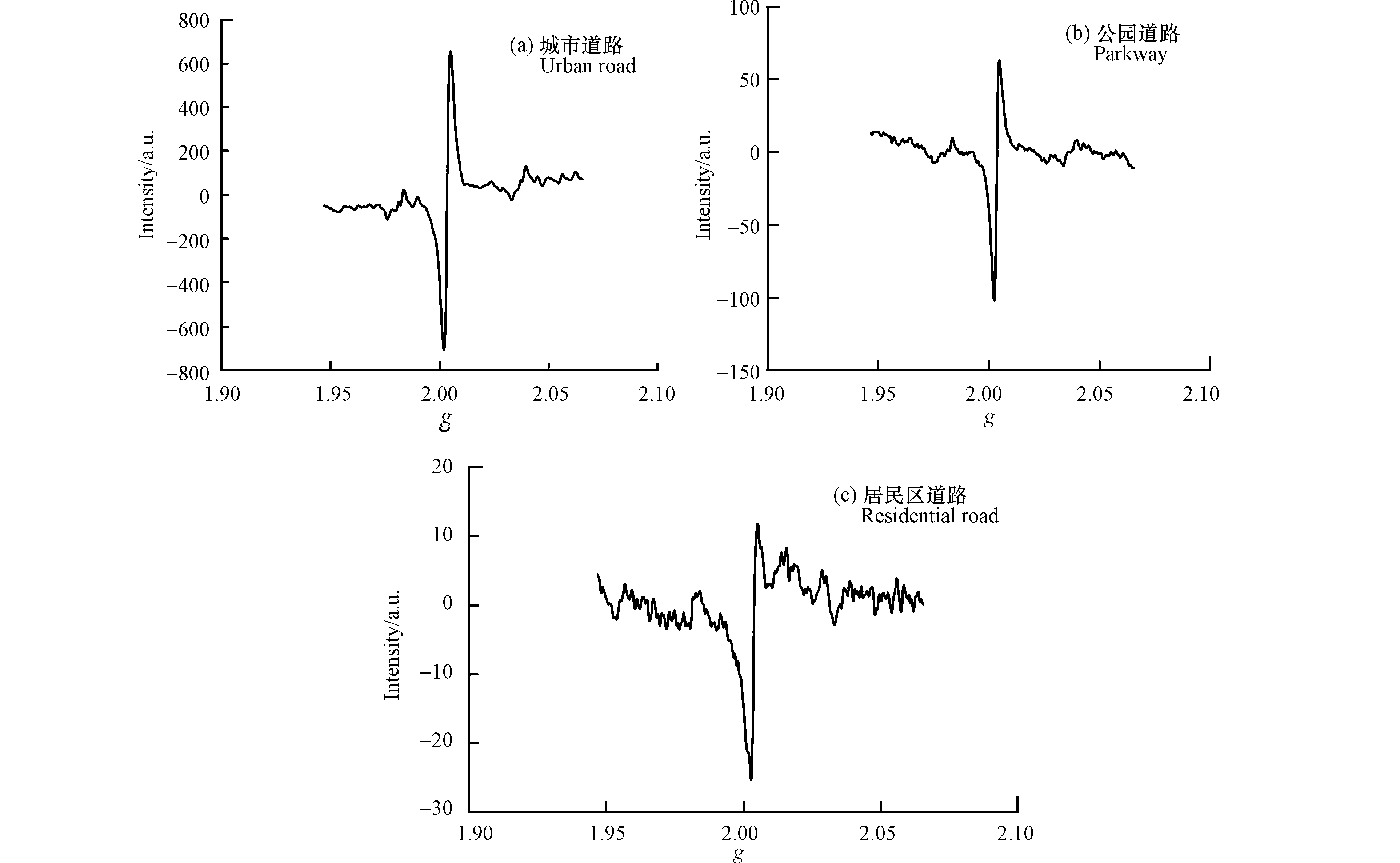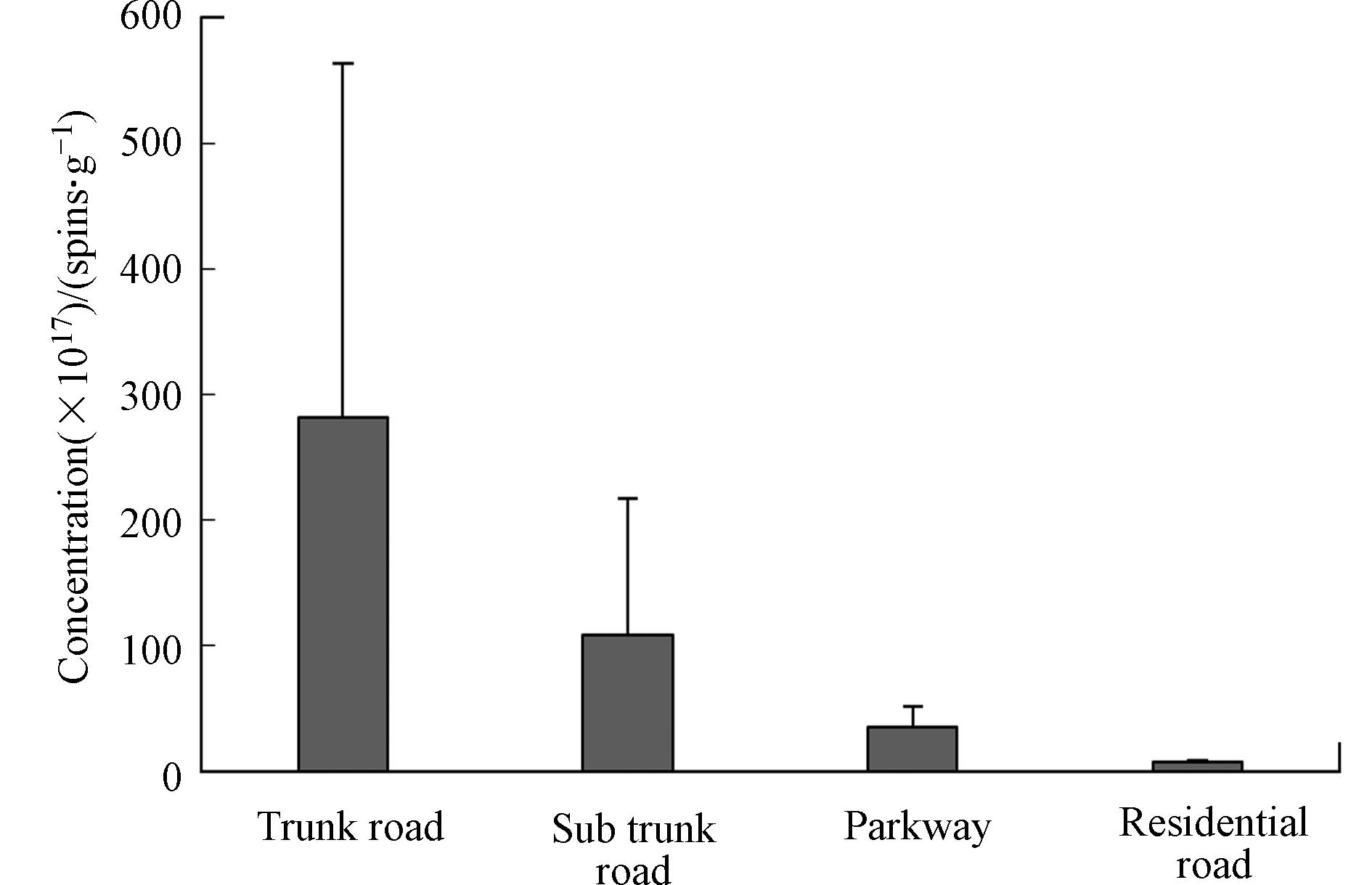-
环境持久性自由基(EPFRs)是一类新型污染物,具有稳定性、持久性、迁移性及高反应活性等特征,能产生一定环境风险[1]。此类污染物能损伤生物DNA、引发肺部和心血管疾病,威胁人体健康,因此,成为近年来环境领域研究关注的热点[2]。EPFRs不仅存在于机体代谢过程中,也广泛存在于各种环境介质中,目前土壤、大气颗粒物、生物质炭、飞灰等介质中均含有一定量的EPFRs[3-6]。城市道路灰尘所处环境界面特殊,受人类活动影响是多种污染物的汇集场所。道路灰尘作为多种污染物载体,其中细颗粒物可能会因交通和风力的扰动作用,重新扬起再次进入大气,影响环境空气质量[7-8]。道路灰尘也常表现出对大气颗粒物的“源”效应,据报道,空气中有10%—50%的PM2.5来自地面扬尘[9]。因此,研究道路灰尘中EPFRs的污染特征及其环境风险,对城市环境评估和治理有重要的基础和实践意义。
近些年国内外学者对常见环境介质中EPFRs的污染、产生机理和环境风险等方面的研究取得了一定进展。例如,对目前研究分析的结果表明,大气颗粒物中EPFRs的含量在1.60 × 1016 spins·g−1到5.35 × 1018 spins·g−1之间[10],也有结果显示北京2016年冬季雾霾期间PM2.5中EPFRs的含量可达1.60 × 1020 spins·g−1[10]。大气颗粒物中EPFRs的检测得到的g值在2.0027至2.0048之间,根据一般判定规律可知大气颗粒物中的EPFRs为与氧原子相邻的以碳原子为中心的自由基[11]。环境介质中的EPFRs一般由前驱有机物和过渡性金属氧化物在多种环境条件共同作用下产生[12-13]。有研究显示芳香族化合物中的苯环结构可为过渡性金属提供电子,促进了以碳为中心的EPFRs的形成[14]。多环芳烃类有机污染物也会被氧化为酚类和醌类化合物,进而形成半醌自由基和苯氧自由基[14-15]。由于香烟烟雾中自由基类型与PM2.5接近,目前EPFRs的人体健康风险评价采用的方法多为当量香烟数法,即根据空气PM2.5的浓度、人体呼吸速率、PM2.5中自由基含量、香烟焦油中自由基含量和香烟焦油量等主要参数计算当量香烟数[1, 16]。当量香烟数的意义为每天从PM2.5中吸入的自由基相当于吸食香烟的数量,这种评价方法便于人们直观认识EPFRs对健康的危害,因此被广泛采用。
目前,关于EPFRs的研究仍存在不足,尤其缺少道路灰尘中EPFRs关于污染特征及健康风险评估方面的研究,致使人们对道路灰尘EPFRs的污染分布规律、形成及其对人体健康影响的认识并不清楚。因此,本研究选择中原城市群快速城镇化的周口市作为研究区域,对典型城市区域道路灰尘进行采样,并采用电子顺磁共振波谱法(EPR)检测,分析不同功能区道路灰尘中EPFRs的含量特征,根据g因子大小判定道路灰尘中的EPFRs种类。采用当量香烟数法对因吸入道路灰尘产生的健康风险进行评估。研究结果将促进人们对城市道路灰尘中EPFRs污染特征及健康风险的认识,也进一步研究城市道路灰尘中EPFRs的形成机制提供理论依据。
-
以中原城市群核心区快速城镇化的周口市为研究区域,选择公园、居民区和道路3种不同类型功能区道路,设置44个采样点,并采集道路灰尘样品。3种功能区采样点设置数量分别为公园6个、居民区10个、道路28个。根据道路分级将城市道路安机动车道数分为主干道(双向8车道)和次干道(双向6车道),设置采样点数分别为12个和16个。采样点分布见图1。道路灰尘采样依据环境保护标准《防治城市扬尘污染技术规范》(HJ/T 393—2007)的积尘监测方法进行。为避免特殊天气的影响,采样时间须选择天气连续晴朗1周后进行,研究最终确定的采样日期为2020年11月14日。研究采用无线手持式真空吸尘器(300 W,V101 Pro型,苏州艾维诺有限公司)采集灰尘样品,在每个取样点分别采集3个次级样品,混合成一个样品。样品用锡纸包好,放入铝箔袋中[17],标记采样时间、地点后贴在相应样品袋上,并记录功能区类型和道路情况等信息,在各采样点用便携式GPS定位系统定位,记录样点坐标。灰尘样品放入−20 ℃冰箱中保存,备用[17]。
-
研究采用EPR光谱仪(MS5000,布鲁克,德国)测定灰尘样品中的EPFRs。综合前人研究大气颗粒物中EPFRs测定技术的参数[18]。通过设置不同仪器参数寻求测定EPFRs的最优参数,最终确定仪器最优参数为:磁场强度,328—348 mT;检测时间,60 s;微波强度,3 mW;调制频率,100 kHz;调制幅度,0.1 mT;接收增益,15.2 dB。
EPR测试采用由Cr3+和MgO组成的标准物质。通过使用EPR程序WinEPR处理获得g值、信号强度和Hpp,该程序可以提供用户熟悉的界面,同时能保证数据采集和处理所需的可靠性。该方法可以模拟校准样品中EPFRs的自旋绝对值和g因子[1]。通过下式计算各灰尘样品中EPFRs的含量(Cx)[19]:
式中,C0为标准参考物质单位质量的总自旋数,spins·g−1;Hppx、Hpp0分别为灰尘样品和标准样品一次微分的EPR波谱的峰-峰高度;∆Hppx、∆Hpp0分别为灰尘样品和标准样品一次微分的EPR波谱的峰-峰宽度;(∆Hpp)2乘以Hpp可以计算出信号峰值面积。
-
研究结合美国环保局推荐的健康风险评估模型和当量香烟数评估模型作为评估方法,估计通过口腔和鼻腔呼吸吸入再悬浮灰尘携带EPFRs的当量香烟数量。评价经口、鼻日平均吸入道路灰尘EPFRs的量(Dinh)采用下式计算[20]:
式中,C为道路灰尘中EPFRs的含量,spins·g−1;InhR为吸入含有道路灰尘的空气的速率,m3·d−1;ED是暴露持续时间,a;EF是暴露频率,d·a−1;AT是平均作用时间,d;DEF为粉尘排放因子,m3·kg−1;每日因吸入粉尘而吸入的EPFRs的当量香烟数计算公式为[1]:
式中,RCcig为香烟焦油中EPFRs的含量,取4.75 × 1016 spins·g−1[21];Ctar为每支香烟的焦油含量,取0.013 g[1]。模型计算所需参数取值如表1所示。
-
图2为不同功能区道路灰尘EPFRs的EPR信号谱图,结果显示,测定结果谱图的g值范围为1.9465—2.0657,在此g值范围内,不同类型道路灰尘样品中EPFRs信号强度各不相同。道路灰尘中EPFRs信号变化范围较大为−700—700 A.U.(图2a),其次为公园,其灰尘中EPFRs信号变化范围−110—80 A.U.(图2b),居民区地面EPFRs的信号变化范围最小为−25—15 A.U.(图2c)。由于g值范围一定时,信号强度与波谱曲线下的面积,即自旋含量,存在正比关系[19]。说明不同类型功能区地面灰尘中EPFRs的污染可能表现出不同特征。
统计分析表明,道路灰尘中EPFRs的g因子范围为2.0032—2.0037,其均值为2.0036,其峰-峰线宽∆Hppx的范围为3.6—8.0 G,均值为5.1 G,说明灰尘样品中主要是以碳原子为中心及其邻近有含氧官能团的多种类混合型持久性自由基。图3为不同功能区类型道路灰尘中EPFRs的g因子分布特征。结果表明,不同类型的道路灰尘中EPFRs的g因子值差异较小。公园道路灰尘中EPFRs的g因子的范围为2.0035—2.0037,居民区和主干道灰尘中EPFRs的g因子范围均为2.0034—2.0037,次干道灰尘中EPFRs的g因子范围为2.0032—2.0037。这也说明不同城市功能区道路灰尘中EPFRs的类型较为相近。
g因子值与线宽值都可以用来判断自由基的类型,目前主要以g因子值来初步判断自由基类型的归属[10]。若要对自由基分类进行精确判定,还需要基于密度泛函理论的分子优化和模拟计算,才能得到原子核的精细分裂常数值,通过波谱曲线拟合,得到理论谱图,再将测定曲线与理论曲线对比验证自由基分类[25]。有研究将自由基分为30个类别,给出了精细分裂常数值和g因子值,可供分析判断[26]。最新研究显示,道路沥青中EPFRs的g因子值为2.0032—2.0038,与本研究g因子值结果非常接近,归属也为以碳原子为中心和以氧原子为中心的混合自由基,即主要为芳烃自由基和半醌自由基[27],进一步暗示沥青和城市道路灰尘EPFRs的形成可能有内在的关系。北京和西安市PM2.5中EPFRs谱线图的g因子值为2.0030—2.0048,∆Hppx值为4.7—7.9 G,均被判断为以氧为中心或以碳为中心邻近含有杂原子的混合型自由基[18, 28]。这也从另一方面说明了大气颗粒物与道路灰尘之间可能存在一定的联系,即大气中悬浮颗粒物可能与道路灰尘之间有一定的相互迁移和交换。
-
采用EPR检测获取EPFRs的信号及特征数据,代入公式(1)计算得到样品中EPFRs的含量。图4所示为不同类型城市功能区道路灰尘EPFRs含量。研究结果表明,道路灰尘中EPFRs平均含量为1.26 × 1019 spins·g−1,含量范围为4.63 × 1017—6.72 × 1019 spins·g−1。公园、居民区、主干道及次干道灰尘中EPFRs的平均含量分别为3.51 × 1018、7.16 × 1017、2.82 × 1019、1.09 × 1019 spins·g−1。对比不同类型城市功能区道路灰尘EPFRs含量,呈现出主干道>次干道>公园>居民区的一般规律,城市道路道路灰尘中EPFRs含量显著高于公园和居民区,且主干道灰尘中EPFRs的平均含量显著高于次干道,公园道路灰尘中EPFRs含量显著高于居民区。
不同城市功能区的服务功能不同,人类活动干扰类型也不相同,可能是造成不同功能区灰尘EPFRs分布产生差异的原因之一。已有研究表明EPFRs的形成通常是在前驱有机物与过渡金属(如Fe、Cu或Mn等)与环境条件相互作用下产生并逐步稳定化的过程[26, 29]。城市道路灰尘中EPFRs的含量高于公园和居民区,主干道EPFRs含量大于次干道,其主要原因可能是道路灰尘中含有机动车排放的大量尾气颗粒物,其中包含重金属、有机污染物以及其它固态污染物杂质,尾气颗粒有很强的吸附性,会吸附空气中的其他有机污染物,为EPFRs在道路灰尘中的形成提供了条件[30]。相关研究表明,住宅区和公园道路灰尘中金属和有机污染物的含量均低于道路[31],灰尘中多环芳烃类有机污染物受动车排放影响较大[32],因此,在前驱物含量较低的影响下,两类功能区道路灰尘能够产生的EPFRs的量也少于一般城市道路。另外,相对于住宅区,公园区域场地一般比较开阔,且周围分布有密集的交通路网,当车流量较大时,机动车运行扰动地面灰尘,使之再悬浮进入空气中,加之机动车本身产生的尾气颗粒物都具有一定的流动性,可能会通过气流传输再沉降到公园地表中,使公园道路灰尘的EPFRs含量增加。反言之,居民区相比公园更封闭,其受到机动车扰动及尾气排放的影响相对较小,因此,居民区道路灰尘中EPFRs的含量更小些。
-
研究采用健康风险模型评估每人每天通过吸入道路灰尘EPFRs的暴露量,再采用当量香烟数来估算暴露风险。研究分别对不同城市功能区情景下成人和儿童的暴露风险进行了计算(表2),结果显示,对于儿童,EPFRs暴露量在公园约为0.01—0.06支香烟,居民区约为0.004—0.008支香烟,一般道路中约为0.01—0.58支香烟,其中主干道约为0.03—0.58支香烟,次干道约为0.01—0.53支香烟。对于成人,EPFRs暴露量在公园约为0.03—0.16支香烟,居民区约为0.01—0.02支香烟,道路中约0.03—1.53支香烟,其中主干道约为0.09—1.53支香烟,次干道约为0.03—1.40支香烟。按照EPFRs平均含量计算出儿童每人每天通过吸入道路灰尘进入体内的EPFRs量相当于0.1支香烟,成人每人每天吸入体内的EPFRs量相当于0.3支香烟。
总体而言,无论在何种功能区情境下,儿童的吸入灰尘EPFRs暴露量均低于成人。无论儿童还是成人,在城市道路情境下人体吸入灰尘EPFRs暴露量均大于公园和居民区,而公园中EPFRs暴露量均大于居民区。这与前文研究不同城市区域EPFRs含量的结果对应一致。成人在城市道路情境下吸入来自道路灰尘的EPFRs暴露量与美国一些地区吸入PM2.5的EPFRs暴露量的研究结果较为接近[1]。西安市PM2.5中EPFRs来源解析相关研究结果显示,机动车尾气排放是大气颗粒物中EPFRs首要来源,其贡献率为32.1%[33]。尾气颗粒在空气中结合其它污染物沉降至地面成为地面灰尘,受交通状况和环境因素影响会再次浮起进入大气中,进而通过人体呼吸进入体内对人体健康造成一定风险[34-35]。目前,道路灰尘与大气颗粒物的交换传输及灰尘中EPFRs的形成机制等问题还尚不清楚,需进一步开展相关研究。
-
(1)城市道路灰尘中EPFRs含量范围为4.63×1017—6.72×1019 spins·g−1,平均含量为1.26×1019 spins·g−1。
(2)一般城市道路灰尘中EPFRs含量高于其它功能区道路灰尘,其分布呈现出主干道>次干道>公园>居民区的规律。
(3)城市道路灰尘中EPFRs的g因子范围为2.0032—2.0037,其主要是以碳原子为中心及其邻近有含氧官能团的多种类混合型持久性自由基。
(4)城市道路条件下,人体吸入灰尘EPFRs暴露量均高于其它功能区。儿童每人每天通过吸入灰尘进入体内的EPFRs量约相当于0.01—0.58支香烟(均值为0.1支),而成人每人每天吸入体内的EPFRs量约相当于0.03—1.53支香烟(均值为0.3支)。
城市道路灰尘中环境持久性自由基污染特征及暴露评估
Pollution characteristics and human exposure assessment to environmental persistent free radicals in urban road dust
-
摘要: 环境持久性自由基(EPFRs)是一类具有一定环境风险的新型污染物,对人体健康有一定的威胁,引发了广泛关注。以中原城市群核心区快速城镇化的周口市为研究区域,采集包括一般城市道路、公园道路和居民区道路共44个样点的灰尘。研究确定了电子顺磁共振波谱法测定道路灰尘中EPFRs的优化参数,描述了道路灰尘中EPFRs污染及分布特征,并对道路灰尘EPFRs进行定量暴露评估。研究结果表明,道路灰尘中EPFRs含量为4.63×1017—6.72×1019 spins·g−1,平均含量为1.26×1019 spins·g−1,呈现出城市主干道>次干道>公园>居民区的变化特征。城市道路灰尘中EPFRs的g值范围为2.0032—2.0037,主要是以碳原子为中心及其邻近有含氧官能团的多种类混合型持久性自由基。通过建立暴露风险评估模型计算,城市道路条件下人体吸入灰尘EPFRs暴露量均高于其它功能区。儿童每人每天通过吸入灰尘进入体内的EPFRs量约相当于0.01—0.58支香烟(均值为0.1支),而对于成人此值为0.03—1.53支香烟(均值为0.3支)。研究结果为道路灰尘中EPFRs的污染研究提供基础资料,也为进一步研究道路灰尘中EPFRs形成提供理论依据。Abstract: Environmentally persistent free radicals (EPFRs) have recently aroused widespread concern as a new type of environmental risk substances due to their potential adverse health effects. In this study, Zhoukou, a rapidly developing city in the core area of Central Plains Urban Agglomeration (CPUA) was selected as the study area. A total of 44 dust samples including road, park and residential street were collected in this area. The working parameters of electron paramagnetic resonance (EPR) for EPFRs detection were presented, the pollution characteristics and distribution of EPFRs in road dust were described, and associated heath risk was evaluated. The results showed that the average concentration of EPFRs in the road dust was 1.26×1019 spins·g−1, in the range of 4.63×1017 spins·g−1 to 6.72×1019 spins·g−1, and the order of average of EPFR concentration was trunk road > sub trunk road > parkway > residential road. The g-value of EPR signal in road dust was 2.0032 to 2.0036, indicated that the EPFRs in road dust consist of carbon-centered radicals or carbon-centered radicals with nearby oxygen or halogen atoms. The calculation by using combined model showed that the EPFRs exposure via inhalation of dust in urban road was higher than that in other functional area. For the children, the amount of EPFRs inhaled in the body was equivalent to 0.01—0.58 cigarettes (on average, 0.1 cigarettes) per day, and 0.03—1.53 cigarettes (on average, 0.3 cigarettes) per day for adults. The results can provide the basic information for EPFRs in road dust and can also offer support for the further study of EPFR formation in road dust.
-
Key words:
- environmental persistent free radicals /
- road /
- dust /
- exposure /
- risk
-
环境持久性自由基(EPFRs)是一类新型污染物,具有稳定性、持久性、迁移性及高反应活性等特征,能产生一定环境风险[1]。此类污染物能损伤生物DNA、引发肺部和心血管疾病,威胁人体健康,因此,成为近年来环境领域研究关注的热点[2]。EPFRs不仅存在于机体代谢过程中,也广泛存在于各种环境介质中,目前土壤、大气颗粒物、生物质炭、飞灰等介质中均含有一定量的EPFRs[3-6]。城市道路灰尘所处环境界面特殊,受人类活动影响是多种污染物的汇集场所。道路灰尘作为多种污染物载体,其中细颗粒物可能会因交通和风力的扰动作用,重新扬起再次进入大气,影响环境空气质量[7-8]。道路灰尘也常表现出对大气颗粒物的“源”效应,据报道,空气中有10%—50%的PM2.5来自地面扬尘[9]。因此,研究道路灰尘中EPFRs的污染特征及其环境风险,对城市环境评估和治理有重要的基础和实践意义。
近些年国内外学者对常见环境介质中EPFRs的污染、产生机理和环境风险等方面的研究取得了一定进展。例如,对目前研究分析的结果表明,大气颗粒物中EPFRs的含量在1.60 × 1016 spins·g−1到5.35 × 1018 spins·g−1之间[10],也有结果显示北京2016年冬季雾霾期间PM2.5中EPFRs的含量可达1.60 × 1020 spins·g−1[10]。大气颗粒物中EPFRs的检测得到的g值在2.0027至2.0048之间,根据一般判定规律可知大气颗粒物中的EPFRs为与氧原子相邻的以碳原子为中心的自由基[11]。环境介质中的EPFRs一般由前驱有机物和过渡性金属氧化物在多种环境条件共同作用下产生[12-13]。有研究显示芳香族化合物中的苯环结构可为过渡性金属提供电子,促进了以碳为中心的EPFRs的形成[14]。多环芳烃类有机污染物也会被氧化为酚类和醌类化合物,进而形成半醌自由基和苯氧自由基[14-15]。由于香烟烟雾中自由基类型与PM2.5接近,目前EPFRs的人体健康风险评价采用的方法多为当量香烟数法,即根据空气PM2.5的浓度、人体呼吸速率、PM2.5中自由基含量、香烟焦油中自由基含量和香烟焦油量等主要参数计算当量香烟数[1, 16]。当量香烟数的意义为每天从PM2.5中吸入的自由基相当于吸食香烟的数量,这种评价方法便于人们直观认识EPFRs对健康的危害,因此被广泛采用。
目前,关于EPFRs的研究仍存在不足,尤其缺少道路灰尘中EPFRs关于污染特征及健康风险评估方面的研究,致使人们对道路灰尘EPFRs的污染分布规律、形成及其对人体健康影响的认识并不清楚。因此,本研究选择中原城市群快速城镇化的周口市作为研究区域,对典型城市区域道路灰尘进行采样,并采用电子顺磁共振波谱法(EPR)检测,分析不同功能区道路灰尘中EPFRs的含量特征,根据g因子大小判定道路灰尘中的EPFRs种类。采用当量香烟数法对因吸入道路灰尘产生的健康风险进行评估。研究结果将促进人们对城市道路灰尘中EPFRs污染特征及健康风险的认识,也进一步研究城市道路灰尘中EPFRs的形成机制提供理论依据。
1. 材料与方法(Materials and methods)
1.1 道路灰尘样品的采集
以中原城市群核心区快速城镇化的周口市为研究区域,选择公园、居民区和道路3种不同类型功能区道路,设置44个采样点,并采集道路灰尘样品。3种功能区采样点设置数量分别为公园6个、居民区10个、道路28个。根据道路分级将城市道路安机动车道数分为主干道(双向8车道)和次干道(双向6车道),设置采样点数分别为12个和16个。采样点分布见图1。道路灰尘采样依据环境保护标准《防治城市扬尘污染技术规范》(HJ/T 393—2007)的积尘监测方法进行。为避免特殊天气的影响,采样时间须选择天气连续晴朗1周后进行,研究最终确定的采样日期为2020年11月14日。研究采用无线手持式真空吸尘器(300 W,V101 Pro型,苏州艾维诺有限公司)采集灰尘样品,在每个取样点分别采集3个次级样品,混合成一个样品。样品用锡纸包好,放入铝箔袋中[17],标记采样时间、地点后贴在相应样品袋上,并记录功能区类型和道路情况等信息,在各采样点用便携式GPS定位系统定位,记录样点坐标。灰尘样品放入−20 ℃冰箱中保存,备用[17]。
1.2 灰尘中EPFRs测定
研究采用EPR光谱仪(MS5000,布鲁克,德国)测定灰尘样品中的EPFRs。综合前人研究大气颗粒物中EPFRs测定技术的参数[18]。通过设置不同仪器参数寻求测定EPFRs的最优参数,最终确定仪器最优参数为:磁场强度,328—348 mT;检测时间,60 s;微波强度,3 mW;调制频率,100 kHz;调制幅度,0.1 mT;接收增益,15.2 dB。
EPR测试采用由Cr3+和MgO组成的标准物质。通过使用EPR程序WinEPR处理获得g值、信号强度和Hpp,该程序可以提供用户熟悉的界面,同时能保证数据采集和处理所需的可靠性。该方法可以模拟校准样品中EPFRs的自旋绝对值和g因子[1]。通过下式计算各灰尘样品中EPFRs的含量(Cx)[19]:
Cx=C0×Hppx×(ΔHppx)2Hpp0×(ΔHpp0)2 (1) 式中,C0为标准参考物质单位质量的总自旋数,spins·g−1;Hppx、Hpp0分别为灰尘样品和标准样品一次微分的EPR波谱的峰-峰高度;∆Hppx、∆Hpp0分别为灰尘样品和标准样品一次微分的EPR波谱的峰-峰宽度;(∆Hpp)2乘以Hpp可以计算出信号峰值面积。
1.3 暴露风险评估
研究结合美国环保局推荐的健康风险评估模型和当量香烟数评估模型作为评估方法,估计通过口腔和鼻腔呼吸吸入再悬浮灰尘携带EPFRs的当量香烟数量。评价经口、鼻日平均吸入道路灰尘EPFRs的量(Dinh)采用下式计算[20]:
Dinh=C×InhR×EF×EDDEF×AT (2) 式中,C为道路灰尘中EPFRs的含量,spins·g−1;InhR为吸入含有道路灰尘的空气的速率,m3·d−1;ED是暴露持续时间,a;EF是暴露频率,d·a−1;AT是平均作用时间,d;DEF为粉尘排放因子,m3·kg−1;每日因吸入粉尘而吸入的EPFRs的当量香烟数计算公式为[1]:
Ncig=DinhRCcig×Ctar (3) 式中,RCcig为香烟焦油中EPFRs的含量,取4.75 × 1016 spins·g−1[21];Ctar为每支香烟的焦油含量,取0.013 g[1]。模型计算所需参数取值如表1所示。
表 1 暴露评估参数的取值Table 1. The value of parameter of exposure assessment2. 结果与讨论 (Results and discussion)
2.1 灰尘中EPFRs种类特征
图2为不同功能区道路灰尘EPFRs的EPR信号谱图,结果显示,测定结果谱图的g值范围为1.9465—2.0657,在此g值范围内,不同类型道路灰尘样品中EPFRs信号强度各不相同。道路灰尘中EPFRs信号变化范围较大为−700—700 A.U.(图2a),其次为公园,其灰尘中EPFRs信号变化范围−110—80 A.U.(图2b),居民区地面EPFRs的信号变化范围最小为−25—15 A.U.(图2c)。由于g值范围一定时,信号强度与波谱曲线下的面积,即自旋含量,存在正比关系[19]。说明不同类型功能区地面灰尘中EPFRs的污染可能表现出不同特征。
统计分析表明,道路灰尘中EPFRs的g因子范围为2.0032—2.0037,其均值为2.0036,其峰-峰线宽∆Hppx的范围为3.6—8.0 G,均值为5.1 G,说明灰尘样品中主要是以碳原子为中心及其邻近有含氧官能团的多种类混合型持久性自由基。图3为不同功能区类型道路灰尘中EPFRs的g因子分布特征。结果表明,不同类型的道路灰尘中EPFRs的g因子值差异较小。公园道路灰尘中EPFRs的g因子的范围为2.0035—2.0037,居民区和主干道灰尘中EPFRs的g因子范围均为2.0034—2.0037,次干道灰尘中EPFRs的g因子范围为2.0032—2.0037。这也说明不同城市功能区道路灰尘中EPFRs的类型较为相近。
g因子值与线宽值都可以用来判断自由基的类型,目前主要以g因子值来初步判断自由基类型的归属[10]。若要对自由基分类进行精确判定,还需要基于密度泛函理论的分子优化和模拟计算,才能得到原子核的精细分裂常数值,通过波谱曲线拟合,得到理论谱图,再将测定曲线与理论曲线对比验证自由基分类[25]。有研究将自由基分为30个类别,给出了精细分裂常数值和g因子值,可供分析判断[26]。最新研究显示,道路沥青中EPFRs的g因子值为2.0032—2.0038,与本研究g因子值结果非常接近,归属也为以碳原子为中心和以氧原子为中心的混合自由基,即主要为芳烃自由基和半醌自由基[27],进一步暗示沥青和城市道路灰尘EPFRs的形成可能有内在的关系。北京和西安市PM2.5中EPFRs谱线图的g因子值为2.0030—2.0048,∆Hppx值为4.7—7.9 G,均被判断为以氧为中心或以碳为中心邻近含有杂原子的混合型自由基[18, 28]。这也从另一方面说明了大气颗粒物与道路灰尘之间可能存在一定的联系,即大气中悬浮颗粒物可能与道路灰尘之间有一定的相互迁移和交换。
2.2 灰尘中EPFRs污染特征
采用EPR检测获取EPFRs的信号及特征数据,代入公式(1)计算得到样品中EPFRs的含量。图4所示为不同类型城市功能区道路灰尘EPFRs含量。研究结果表明,道路灰尘中EPFRs平均含量为1.26 × 1019 spins·g−1,含量范围为4.63 × 1017—6.72 × 1019 spins·g−1。公园、居民区、主干道及次干道灰尘中EPFRs的平均含量分别为3.51 × 1018、7.16 × 1017、2.82 × 1019、1.09 × 1019 spins·g−1。对比不同类型城市功能区道路灰尘EPFRs含量,呈现出主干道>次干道>公园>居民区的一般规律,城市道路道路灰尘中EPFRs含量显著高于公园和居民区,且主干道灰尘中EPFRs的平均含量显著高于次干道,公园道路灰尘中EPFRs含量显著高于居民区。
不同城市功能区的服务功能不同,人类活动干扰类型也不相同,可能是造成不同功能区灰尘EPFRs分布产生差异的原因之一。已有研究表明EPFRs的形成通常是在前驱有机物与过渡金属(如Fe、Cu或Mn等)与环境条件相互作用下产生并逐步稳定化的过程[26, 29]。城市道路灰尘中EPFRs的含量高于公园和居民区,主干道EPFRs含量大于次干道,其主要原因可能是道路灰尘中含有机动车排放的大量尾气颗粒物,其中包含重金属、有机污染物以及其它固态污染物杂质,尾气颗粒有很强的吸附性,会吸附空气中的其他有机污染物,为EPFRs在道路灰尘中的形成提供了条件[30]。相关研究表明,住宅区和公园道路灰尘中金属和有机污染物的含量均低于道路[31],灰尘中多环芳烃类有机污染物受动车排放影响较大[32],因此,在前驱物含量较低的影响下,两类功能区道路灰尘能够产生的EPFRs的量也少于一般城市道路。另外,相对于住宅区,公园区域场地一般比较开阔,且周围分布有密集的交通路网,当车流量较大时,机动车运行扰动地面灰尘,使之再悬浮进入空气中,加之机动车本身产生的尾气颗粒物都具有一定的流动性,可能会通过气流传输再沉降到公园地表中,使公园道路灰尘的EPFRs含量增加。反言之,居民区相比公园更封闭,其受到机动车扰动及尾气排放的影响相对较小,因此,居民区道路灰尘中EPFRs的含量更小些。
2.3 暴露风险评估
研究采用健康风险模型评估每人每天通过吸入道路灰尘EPFRs的暴露量,再采用当量香烟数来估算暴露风险。研究分别对不同城市功能区情景下成人和儿童的暴露风险进行了计算(表2),结果显示,对于儿童,EPFRs暴露量在公园约为0.01—0.06支香烟,居民区约为0.004—0.008支香烟,一般道路中约为0.01—0.58支香烟,其中主干道约为0.03—0.58支香烟,次干道约为0.01—0.53支香烟。对于成人,EPFRs暴露量在公园约为0.03—0.16支香烟,居民区约为0.01—0.02支香烟,道路中约0.03—1.53支香烟,其中主干道约为0.09—1.53支香烟,次干道约为0.03—1.40支香烟。按照EPFRs平均含量计算出儿童每人每天通过吸入道路灰尘进入体内的EPFRs量相当于0.1支香烟,成人每人每天吸入体内的EPFRs量相当于0.3支香烟。
表 2 每天吸入道路灰尘EPFRs的当量香烟数(支)Table 2. Number of equivalent cigarettes smoked from inhaling road dust类型Types 儿童 Children 成人 Adults 范围 Range 均值 Mean 范围 Range 均值 Mean 主干道 Trunk road 0.03—0.58 0.24 0.09—1.53 0.64 次干道 Sub trunk road 0.01—0.53 0.09 0.03—1.40 0.25 公园道路 Parkway 0.01—0.06 0.03 0.03—0.16 0.08 居民区道路 Residential road 0.004—0.008 0.006 0.01—0.02 0.016 总体而言,无论在何种功能区情境下,儿童的吸入灰尘EPFRs暴露量均低于成人。无论儿童还是成人,在城市道路情境下人体吸入灰尘EPFRs暴露量均大于公园和居民区,而公园中EPFRs暴露量均大于居民区。这与前文研究不同城市区域EPFRs含量的结果对应一致。成人在城市道路情境下吸入来自道路灰尘的EPFRs暴露量与美国一些地区吸入PM2.5的EPFRs暴露量的研究结果较为接近[1]。西安市PM2.5中EPFRs来源解析相关研究结果显示,机动车尾气排放是大气颗粒物中EPFRs首要来源,其贡献率为32.1%[33]。尾气颗粒在空气中结合其它污染物沉降至地面成为地面灰尘,受交通状况和环境因素影响会再次浮起进入大气中,进而通过人体呼吸进入体内对人体健康造成一定风险[34-35]。目前,道路灰尘与大气颗粒物的交换传输及灰尘中EPFRs的形成机制等问题还尚不清楚,需进一步开展相关研究。
3. 结论(Conclusion)
(1)城市道路灰尘中EPFRs含量范围为4.63×1017—6.72×1019 spins·g−1,平均含量为1.26×1019 spins·g−1。
(2)一般城市道路灰尘中EPFRs含量高于其它功能区道路灰尘,其分布呈现出主干道>次干道>公园>居民区的规律。
(3)城市道路灰尘中EPFRs的g因子范围为2.0032—2.0037,其主要是以碳原子为中心及其邻近有含氧官能团的多种类混合型持久性自由基。
(4)城市道路条件下,人体吸入灰尘EPFRs暴露量均高于其它功能区。儿童每人每天通过吸入灰尘进入体内的EPFRs量约相当于0.01—0.58支香烟(均值为0.1支),而成人每人每天吸入体内的EPFRs量约相当于0.03—1.53支香烟(均值为0.3支)。
-
表 1 暴露评估参数的取值
Table 1. The value of parameter of exposure assessment
表 2 每天吸入道路灰尘EPFRs的当量香烟数(支)
Table 2. Number of equivalent cigarettes smoked from inhaling road dust
类型Types 儿童 Children 成人 Adults 范围 Range 均值 Mean 范围 Range 均值 Mean 主干道 Trunk road 0.03—0.58 0.24 0.09—1.53 0.64 次干道 Sub trunk road 0.01—0.53 0.09 0.03—1.40 0.25 公园道路 Parkway 0.01—0.06 0.03 0.03—0.16 0.08 居民区道路 Residential road 0.004—0.008 0.006 0.01—0.02 0.016 -
[1] GEHLING W, DELLINGER B. Environmentally persistent free radicals and their lifetimes in PM2.5 [J]. Environmental Science & Technology, 2013, 47(15): 8172-8178. [2] VEJERANO E P, RAO G Y, KHACHATRYAN L, et al. Environmentally persistent free radicals: Insights on a new class of pollutants [J]. Environmental Science & Technology, 2018, 52(5): 2468-2481. [3] YANG L L, LIU G R, ZHENG M H, et al. Pivotal roles of metal oxides in the formation of environmentally persistent free radicals [J]. Environmental Science & Technology, 2017, 51(21): 12329-12336. [4] JIA H Z, ZHAO S, SHI Y F, et al. Formation of environmentally persistent free radicals during the transformation of anthracene in different soils: Roles of soil characteristics and ambient conditions [J]. Journal of Hazardous Materials, 2019, 362: 214-223. doi: 10.1016/j.jhazmat.2018.08.056 [5] JIA H Z, LI S S, WU L, et al. Cytotoxic free radicals on air-borne soot particles generated by burning wood or low-maturity coals [J]. Environmental Science & Technology, 2020, 54(9): 5608-5618. [6] ODINGA E S, WAIGI M G, GUDDA F O, et al. Occurrence, formation, environmental fate and risks of environmentally persistent free radicals in biochars [J]. Environment International, 2020, 134: 105172. doi: 10.1016/j.envint.2019.105172 [7] JOSE J, SRIMURUGANANDAM B. Application of micro-morphology in the physical characterization of urban road dust [J]. Particuology, 2021, 54: 146-155. doi: 10.1016/j.partic.2020.05.002 [8] LIU E F, YAN T, BIRCH G, et al. Pollution and health risk of potentially toxic metals in urban road dust in Nanjing, a mega-city of China [J]. Science of the Total Environment, 2014, 476/477: 522-531. doi: 10.1016/j.scitotenv.2014.01.055 [9] ERMOLIN M S, FEDOTOV P S, IVANEEV A I, et al. A contribution of nanoscale particles of road-deposited sediments to the pollution of urban runoff by heavy metals [J]. Chemosphere, 2018, 210: 65-75. doi: 10.1016/j.chemosphere.2018.06.150 [10] XU M X, WU T, TANG Y T, et al. Environmentally persistent free radicals in PM2.5: A review [J]. Waste Disposal & Sustainable Energy, 2019, 1(3): 177-197. [11] PAN B, LI H, LANG D, et al. Environmentally persistent free radicals: Occurrence, formation mechanisms and implications [J]. Environmental Pollution, 2019, 248: 320-331. doi: 10.1016/j.envpol.2019.02.032 [12] TRUONG H, LOMNICKI S, DELLINGER B. Potential for misidentification of environmentally persistent free radicals as molecular pollutants in particulate matter [J]. Environmental Science & Technology, 2010, 44(6): 1933-1939. [13] GUO X W, ZHANG N, HU X, et al. Characteristics and potential inhalation exposure risks of PM2.5-bound environmental persistent free radicals in Nanjing, a mega-city in China [J]. Atmospheric Environment, 2020, 224: 117355. doi: 10.1016/j.atmosenv.2020.117355 [14] 王政, 张兴华, 张逦嘉, 等. 大气颗粒物中环境持久性自由基的电子顺磁共振检测方法 [J]. 环境化学, 2020, 39(2): 317-325. doi: 10.7524/j.issn.0254-6108.2019022703 WANG Z, ZHANG X H, ZHANG L J, et al. Detection of environmentally persistent free radicals in atmospheric particulate matter by electron paramagnetic resonance [J]. Environmental Chemistry, 2020, 39(2): 317-325(in Chinese). doi: 10.7524/j.issn.0254-6108.2019022703
[15] WANG P, PAN B, LI H, et al. The overlooked occurrence of environmentally persistent free radicals in an area with low-rank coal burning, Xuanwei, China [J]. Environmental Science & Technology, 2018, 52(3): 1054-1061. [16] XU Y, YANG L L, WANG X P, et al. Risk evaluation of environmentally persistent free radicals in airborne particulate matter and influence of atmospheric factors [J]. Ecotoxicology and Environmental Safety, 2020, 196: 110571. doi: 10.1016/j.ecoenv.2020.110571 [17] WANG C, HUANG Y P, ZHANG Z T, et al. Levels, spatial distribution, and source identification of airborne environmentally persistent free radicals from tree leaves [J]. Environmental Pollution, 2020, 257: 113353. doi: 10.1016/j.envpol.2019.113353 [18] CHEN Q C, SUN H Y, MU Z, et al. Characteristics of environmentally persistent free radicals in PM2.5: Concentrations, species and sources in Xi'an, Northwestern China [J]. Environmental Pollution, 2019, 247: 18-26. doi: 10.1016/j.envpol.2019.01.015 [19] 卢景雰. 现代电子顺磁共振波谱学及其应用[M]. 北京: 北京大学医学出版社, 2012. LU J F. Advanced electron paramagnetic resonance spectroscopy and its applications[M]. Beijing: Peking University Medical Press, 2012(in Chinese).
[20] USEPA. Supplemental guidance for developing soil screening levels for superfund sites[R]. Washington, DC: U. S. Environmental Protection Agency, 2002. [21] PRYOR W A, PRIER D G, CHURCH D F. Electron-spin resonance study of mainstream and sidestream cigarette smoke: Nature of the free radicals in gas-phase smoke and in cigarette tar [J]. Environmental Health Perspectives, 1983, 47: 345-355. doi: 10.1289/ehp.8347345 [22] 中华人民共和国环境保护部. 中华人民共和国环保行业标准: 污染场地风险评估技术导则 HJ 25.3—2014[S]. 北京: 中国环境科学出版社, 2014. Ministry of Environmental Protection of the People’s Republic of China. Environmental Protection Standard of the People's Republic of China: Technical guidelines for risk assessment of contaminated sites. HJ 25.3—2014[S]. Beijing: China Environment Science Press, 2014(in Chinese).
[23] 段小丽. 中国人群暴露参数手册(儿童卷)概要[M]. 北京: 中国环境出版社, 2016. DUAN X. Exposure Factors Handbook of Chinese Population[M]. Beijing: China Environmental Press, 2013 (in Chinese).
[24] SHAHAB A, ZHANG H, ULLAH H, et al. Pollution characteristics and toxicity of potentially toxic elements in road dust of a tourist city, Guilin, China: Ecological and health risk assessment [J]. Environmental Pollution, 2020, 266: 115419. doi: 10.1016/j.envpol.2020.115419 [25] MCCRACKEN J. Electron paramagnetic resonance: A practitioner's toolkit [J]. Journal of the American Chemical Society, 2009, 131(36): 13181. [26] 阮秀秀, 杜巍萌, 郭凡可, 等. 环境持久性自由基的环境化学行为 [J]. 环境化学, 2018, 37(8): 1780-1788. doi: 10.7524/j.issn.0254-6108.2017123002 RUAN X X, DU W M, GUO F K, et al. Environmental and chemical behaviors of environmental persistent free radicals [J]. Environmental Chemistry, 2018, 37(8): 1780-1788(in Chinese). doi: 10.7524/j.issn.0254-6108.2017123002
[27] 林浩, 李豪, 孙浩堯, 等. 道路沥青中长寿命自由基特征及二次生成 [J]. 中国环境科学, 2021, 41(3): 1102-1108. doi: 10.3969/j.issn.1000-6923.2021.03.012 LIN H, LI H, SUN H Y, et al. Characteristics and secondary formation of EPFRs in road asphalt [J]. China Environmental Science, 2021, 41(3): 1102-1108(in Chinese). doi: 10.3969/j.issn.1000-6923.2021.03.012
[28] YANG L L, LIU G R, ZHENG M H, et al. Highly elevated levels and particle-size distributions of environmentally persistent free radicals in haze-associated atmosphere [J]. Environmental Science & Technology, 2017, 51(14): 7936-7944. [29] DELA CRUZ A L N, GEHLING W, LOMNICKI S, et al. Detection of environmentally persistent free radicals at a superfund wood treating site [J]. Environmental Science & Technology, 2011, 45(15): 6356-6365. [30] CIARKOWSKA K, GAMBUS F, ANTONKIEWICZ J, et al. Polycyclic aromatic hydrocarbon and heavy metal contents in the urban soils in southern Poland [J]. Chemosphere, 2019, 229: 214-226. doi: 10.1016/j.chemosphere.2019.04.209 [31] 向丽, 李迎霞, 史江红, 等. 北京城区道路灰尘重金属和多环芳烃污染状况探析 [J]. 环境科学, 2010, 31(1): 159-167. XIANG L, LI Y X, SHI J H, et al. Investigation of heavy metal and polycyclic aromatic hydrocarbons contamination in street dusts in urban Beijing [J]. Environmental Science, 2010, 31(1): 159-167(in Chinese).
[32] 李琦路, 吴锦涛, 张颖, 等. 新乡市机动车排放对道路灰尘中重金属与多环芳烃污染的影响 [J]. 环境科学, 2019, 40(12): 5258-5264. LI Q L, WU J T, ZHANG Y, et al. Effects of vehicle emissions on heavy metals and polycyclic aromatic hydrocarbons pollution in road dust in Xinxiang [J]. Environmental Science, 2019, 40(12): 5258-5264(in Chinese).
[33] WANG Y Q, LI S P, WANG M M, et al. Source apportionment of environmentally persistent free radicals (EPFRs) in PM2.5 over Xi'an, China [J]. Science of the Total Environment, 2019, 689: 193-202. doi: 10.1016/j.scitotenv.2019.06.424 [34] LANZERSTORFER C, LOGIEWA A. The upper size limit of the dust samples in road dust heavy metal studies: Benefits of a combined sieving and air classification sample preparation procedure [J]. Environmental Pollution, 2019, 245: 1079-1085. doi: 10.1016/j.envpol.2018.10.131 [35] 冯精兰, 刘书卉, 申君慧, 等. 新乡市道路灰尘中PAHs的污染特征和来源解析 [J]. 环境化学, 2013, 32(4): 630-639. doi: 10.7524/j.issn.0254-6108.2013.04.014 FENG J L, LIU S H, SHEN J H, et al. Pollution characteristics and source appointment of polycyclic aromatic hydrocarbons(PAHs) in road dust from Xinxiang [J]. Environmental Chemistry, 2013, 32(4): 630-639(in Chinese). doi: 10.7524/j.issn.0254-6108.2013.04.014
-





 下载:
下载:




